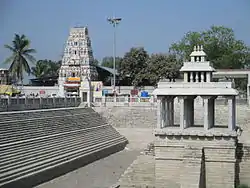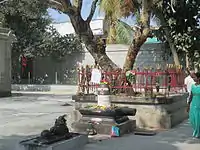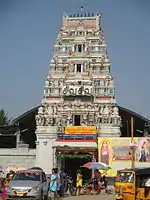Vedapureeswarar temple, Thiruverkadu
Vedapureeswarar Temple is a Hindu temple dedicated to the deity Shiva, located in Thiruverkadu, a Municipality in Tiruvallur district in the South Indian state of Tamil Nadu. Shiva is worshipped as Vedapureeswarar, and is represented by the lingam. His consort Parvati is depicted as Balambigai. The presiding deity is revered in the 7th century Tamil Saiva canonical work, the Tevaram, written by Tamil saint poets known as the Nayanars and classified as Paadal Petra Sthalam.
| Vedapureeswarar Temple | |
|---|---|
 | |
| Religion | |
| Affiliation | Hinduism |
| District | Tiruvallur |
| Deity | Vedapureeswarar(Shiva) |
| Location | |
| State | Tamil Nadu |
| Country | India |
 Location in Tamil Nadu | |
| Geographic coordinates | 13°04′17″N 80°06′53″E |
| Architecture | |
| Type | Dravidian architecture |
The temple complex covers two acres and it houses two gateway towers known as gopurams, each facing the Vedapureeswarar and Balambigai shrine. The temple has a number of shrines, with those of Vedapureeswarar and his consort Balambigai being the most prominent.
The temple has six daily rituals at various times from 6:00 a.m. to 8:30 p.m., and four yearly festivals on its calendar. The Brahmotsavam festival is celebrated during the day of the Magam (February - March) is the most prominent festival.
The original complex is believed to have been built by Cholas, In modern times, the temple is maintained and administered by the Hindu Religious and Charitable Endowments Department of the Government of Tamil Nadu.
Legend
As per Hindu legend, during the divine wedding of Shiva and Parvathi, there was heavy crowd at Kailash, the abode of Shiva. Sage Agasthya could not view event and prayed to Shiva at this place to get him a view of the event. Pleased by his devotion, Shiva appeared to the sage and his wife Lopamundra along with Parvathi in his marriage attire. Shiva made the place his abode and appeared in his marriage posture to Agastya. The same legend is associated with Papanasanathar Temple and Agasthiyar Falls.[1] The temple is also believed to be the place from where Muruga got his weapon to kill the demon king Surapadma.[1]
Architecture

This temple is situated 27 km from Chennai in Thiruverkadu, a municipality in Tiruvallur district. The nearest railway station is at Avadi and the nearest airport is Chennai International Airport. The Shiva temple at Thiruverkadu is spread over an area of 1.5 acres (6,100 m2). The main rajagopuram is on the east side with seven tiers. The temple tank is located outside the main entrance. Inside the temple, there are two corridors. At the main entrance, the sculptures of Ganapathy and Muruga can be found on both the sides. The main shrine accommodates the image of Shiva known as Vedapureeswarar and the Ambal his consort is known as Balambigai. Like the Shiva temples in Thondai Nadu, the sanctum houses lingam and the images of Shiva and Parvathi in wedding posture. There is a separate shrine for Balambigai to the right of Vedapureeswarar's sanctum. The first precinct on the four sides of the sanctum sancotrum are decorated with the images of Nayanmars, Murugan Sannadhi in the northwest and Durga Sannadhi on the northeast. The temple has Navagraha, which is sculpted in a lotus pedestal. The temple has a separate shrine for Arunagirinathar and Murkha Nayanar. There is a prominent sculpture of Karumari Amman in the temple.[1]
Religious importance and festivals

It is one of the shrines of the 275 Paadal Petra Sthalams - Shiva Sthalams glorified in the early medieval Tevaram poems by Tamil Saivite Nayanar Sundarar. The temple also finds mention in Tirumular's Thirumantiram, Arunagirinathar's Tiruppugazh and Manikkavacakar's Tiruvacakam.[2]
The temple priests perform the puja (rituals) during festivals and on a daily basis. The temple rituals are performed six times a day; Kalasanthi at 6:00 a.m., Irandam Kalm at 9:00 a.m., Uchikalam at 12:00 a.m., Sayarakshai at 6:00 p.m, Irandam Kalm at 7:30 p.m., and Arthajamam at 9:00 p.m.. Each ritual comprises four steps: abhisheka (sacred bath), alangaram (decoration), naivethanam (food offering) and deepa aradanai (waving of lamps) for Edaganathar and Elavrkuzhali. There are weekly rituals like somavaram (Monday) and sukravaram (Friday), fortnightly rituals like pradosham, and monthly festivals like amavasai (new moon day), kiruthigai, pournami (full moon day) and sathurthi. Other festivals include Vinayaka Chaturthi, Aadi Pooram, Navaratri, Aippasi Pournami, Skanda Sashti, Kartikai Deepam, Arudra Darisanam, Tai Poosam, Maasi Magam, Panguni Uththiram and Vaikasi Visakam.[1][3]
References
- R., Dr. Vijayalakshmy (2001). An introduction to religion and Philosophy - Tévarám and Tivviyappirapantam (1st ed.). Chennai: International Institute of Tamil Studies. pp. 155–6.
- "Verkadu". Thevaaram.org. 2011. Retrieved 14 March 2016.
- "Sri Vedapureeswarar temple". Dinamalar. 2014. Retrieved 24 November 2015.
External links
| Wikimedia Commons has media related to Vedapureeswar temple, Thiruverkadu. |
